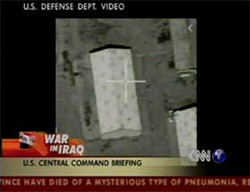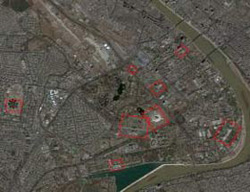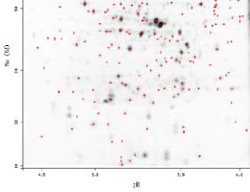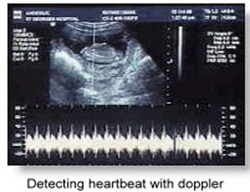>> introduction
short
overview
>> seeing
things/
knowledge
produktion
>> PCM/
'Visibility
is a trap'
>> Latour
- Pasteur/
the
scientific image
>> Abstraction/
the paradox
status
of the visual abstract
>> Conclusion/
outlining
along two strings
----------------
>> Print entire
text
(4 pages)
pdf
or .rtf
----------------
>> movies
(select the format)
1. operational sight
> mov
> wmv
2. pixelated sight
> mov
> wmv
3. black sight
> mov
> wmv |
PCM:
In using the term ‘machinic vision’, J. Johnston describes
it not that much as a simple seeing with or by means of machines - although
it does presuppose this - as it is a decoded seeing, a becoming of perception
in relation to machines that necessarily also involves a recoding [3].
Establishing the visible on the basis of information technology enmeshes
necessarily a predefined code – a pattern – which constitutes
a relation to the used technology. But the dependence on a more or less
universal code, does not give any stable context, therefore the reliance
in the function of abstraction of the entailed processes has great impact
on the perceived. ’Information is not unframed knowledge but knowledge
framed provisionally in unstable data structures.’[4]
In this regard suggestive connections appear to the notion of a 'paranoid'
construction of the world made visible. ‘Then what ever can be more
conspiratorial then a scientific device that deceives?’ J.Hunt asks
and mentions a perfect example illustrating this with B.Latour's analysis
of Pasteur. It shows instantaneously the creation of facts through measurement
and weighing through instruments. But how can one look at something which
only gets created by the act of looking?
This follows the logic of ‘seeing things’ as they are predefined
through interpretation, implied in the assoziations of social reading
and cultural devices. At this point the introduction of the paranoid-critical
method can be used to open up productive channels between interpretation
and theory, paranoia and identity, as J.Hunt explains.
Though what can be seen is a ‘question about who is allowed to look,
to what purposes, and by what academic and state discourses it is legitimated.
... What the eye purportedly 'sees' is dictated to it by an entire set of
beliefs and desires and by a set of coded languages and generic apparatuses.’[5]
Following the same route P.Phelan writes that "Visibility is a trap
...; it summons surveillance and the law; it provokes voyeurism, fetishism,
the colonialist/ imperial appetite for possession.”’[6]
Thus the inherent ambivalence of visibility gets partly revealed, as at
the same time visibility/transparency usually is presumed to show the real
intention of the seen object. It neglects the construction of the visible,
like that actually only the known or the ‘evident’ can be seen.
Returning after this short excursus it became clear that nowadays the construction
and need of evidence is not only a necessity in the field of scientific
vision evolving from the methods used, as equally through the produced amount
of ongoing delegated and digitized visualisation.
[3] Machinic Vision, Kohnston, J., p.29
[4] The Imperial Archive, Richards, T., 1999
[5] The Visual Culture Reader, Rogoff, I., p.21,22
[6] performe or else, McKenzie, J., p.41
|
>>> click into the images to enlarge

smart bomb sight
 satellite image of bagdad with marks
satellite image of bagdad with marks
 ecoli
ecoli

ultrasound with heartbeat analysis |